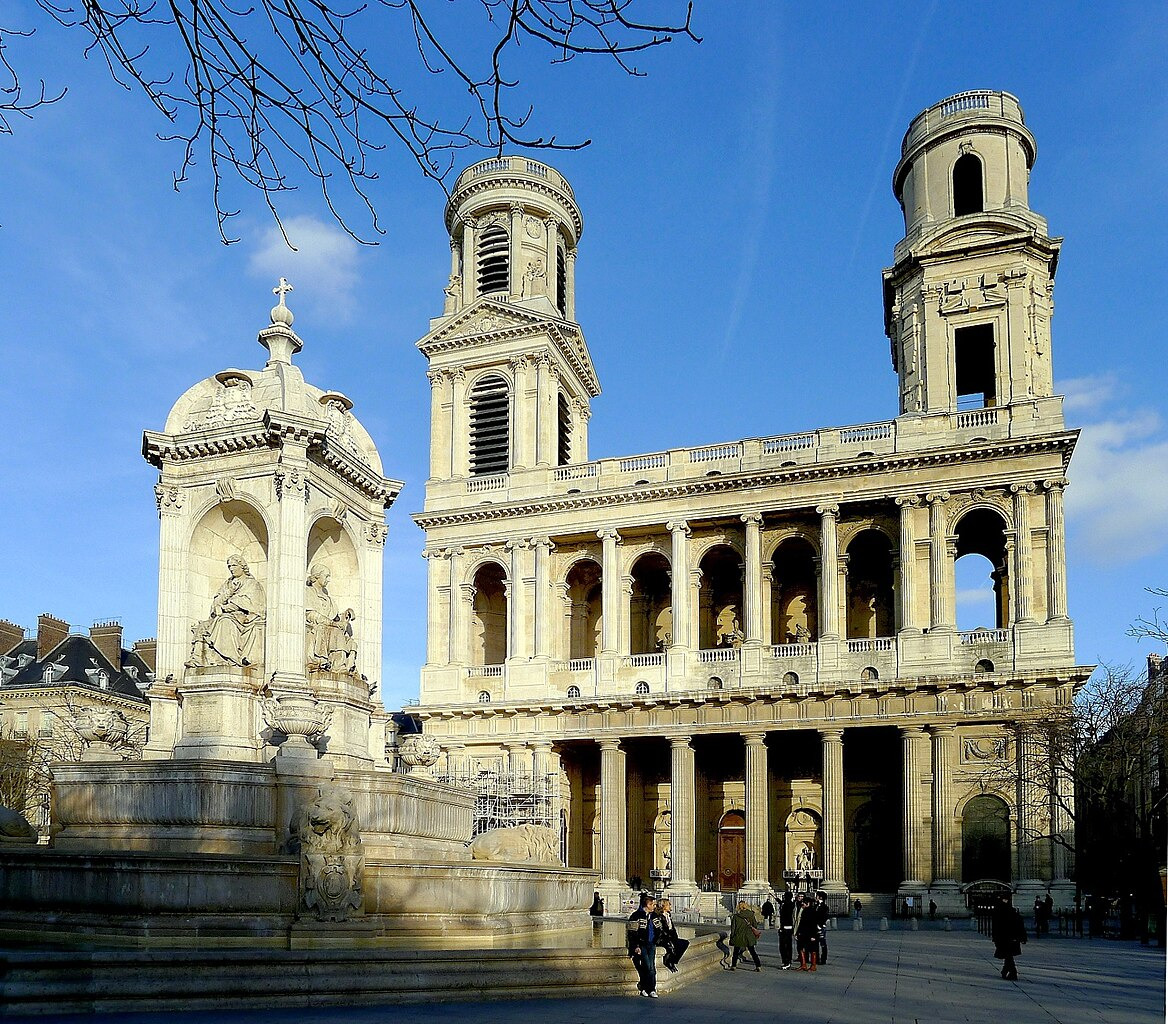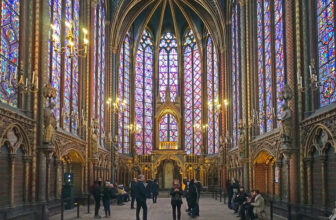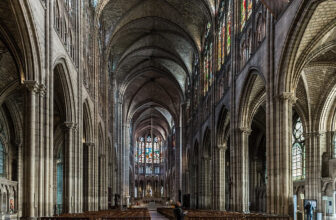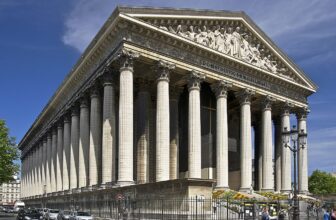
What is Saint Sulpice Paris Famous For?
Nestled in the heart of Paris’s Saint Germain des Prés neighborhood, Saint Sulpice is a majestic church that has drawn visitors and worshippers for centuries. As the second-largest church in Paris after Notre-Dame, it is an architectural marvel steeped in history, art, and spirituality. Saint Sulpice is not just a place of worship; it is a cultural and historical landmark that has captivated tourists, historians, and art lovers alike. It gained additional global fame thanks to its mention in Dan Brown’s best-selling novel, The Da Vinci Code, but its true significance lies far deeper than fictional intrigue.
A Brief History of Saint Sulpice
Construction of Saint Sulpice began in 1646 on the site of an earlier, smaller church dedicated to Saint Sulpicius, a 7th-century bishop of Bourges. Over the course of 140 years, the church underwent numerous architectural changes, which resulted in its distinctive blend of styles. Designed in part by renowned architects such as Christophe Gamard, Louis Le Vau, and Giovanni Servandoni, Saint Sulpice boasts elements of classical, baroque, and neoclassical architecture.
The church has witnessed significant historical events, including the baptism of the Marquis de Sade and the marriage of author Victor Hugo to Adèle Foucher. Despite being damaged during the French Revolution, it remains a symbol of resilience and continuity, standing tall as a testament to Paris’s rich cultural heritage.
What to See Inside Saint Sulpice
Saint Sulpice is a treasure trove of art, architecture, and historical curiosities. Whether you are a history buff, an art enthusiast, or a curious traveler, the church offers something to captivate every visitor. Here are the highlights of what to see inside:
1. The Facade
The impressive two-story facade of Saint Sulpice sets the tone for what lies within. Designed by Giovanni Servandoni, the facade is characterized by its grand columns and symmetry. The two mismatched towers, the north tower remains unfinished, add a quirky charm to the structure. This facade is one of the most iconic features of the church and a masterpiece of French baroque architecture.
2. The Gnomon and the Meridian Line
One of the most intriguing features of Saint-Sulpice is its astronomical gnomon, a scientific instrument used to determine the date of Easter and track the solstices. A brass meridian line runs across the church floor, connecting to an obelisk and a lens on a window that projects sunlight onto the line. This ingenious system was installed in the 18th century by French astronomer Henry Sully. Today, it remains a fascinating blend of science and spirituality, drawing visitors interested in its historical and technical significance.
3. Delacroix’s Frescoes
Eugène Delacroix, one of the most celebrated painters of the Romantic era, left his indelible mark on Saint Sulpice through a series of stunning frescoes. Located in the Chapel of the Holy Angels, these masterpieces include Jacob Wrestling with the Angel and Heliodorus Driven from the Temple. Delacroix’s use of dramatic color and dynamic composition brings these biblical scenes to life, making them a must-see for art lovers.
4. The Great Organ
The organ at Saint Sulpice is one of the largest and most renowned in the world. Built in 1862 by Aristide Cavaillé-Coll, the organ boasts 102 stops and nearly 7,000 pipes. It has been played by some of the greatest organists in history, including Charles-Marie Widor, who served as the church’s organist for over six decades. Even today, the organ’s powerful and ethereal sound is a highlight of the church’s Sunday services and special concerts.
5. The Lady Chapel
The Lady Chapel, located at the eastern end of the church, is an exquisite space dedicated to the Virgin Mary. Its oval dome is adorned with frescoes by François Lemoyne, depicting the Assumption of Mary. The chapel’s harmonious design and serene ambiance make it a perfect spot for quiet reflection.
6. The Baptismal Font
The baptismal font of Saint Sulpice is an elegant marble structure designed by Louis Le Vau. This font has witnessed numerous significant baptisms, including that of the notorious Marquis de Sade. Its intricate carvings and historical significance make it a fascinating feature of the church.
7. The Altar and Pulpit
The high altar of Saint Sulpice is an imposing structure made of marble and gilded bronze. Its grandeur is complemented by the church’s ornate pulpit, which features intricate wood carvings. Together, these elements form the focal point of the church’s interior, embodying its spiritual and artistic richness.
8. The Side Chapels
Saint Sulpice is home to numerous side chapels, each with its own unique charm and artistic treasures. The Chapel of Saint Joseph, for instance, features a stunning painting by Carle Van Loo, while the Chapel of the Holy Angels houses Delacroix’s famous frescoes. Exploring these chapels offers a glimpse into the diverse artistic heritage of the church.
9. The Rose Line
Popularized by Dan Brown’s The Da Vinci Code, the Rose Line is a fictional interpretation of the church’s meridian line. While it may not hold the secret of the Holy Grail, as suggested in the novel, it remains a point of fascination for fans of the book and film. Visitors can follow the brass line on the floor and imagine the mysteries it might hold.
Practical Tips for Visiting Saint Sulpice
- Opening Hours: The church is open daily, but hours may vary depending on religious services. It is advisable to check ahead of your visit.
- Entrance Fee: Entry to Saint Sulpice is free, although donations are welcome.
- Guided Tours: Consider joining a guided tour to gain deeper insights into the church’s history and art.
- Concerts: Check the schedule for organ recitals and concerts, which offer a unique way to experience the church’s acoustics and musical heritage.
- Photography: Non-flash photography is allowed, but be respectful of worshippers.
Why Visit Saint Sulpice?
Saint Sulpice offers a multifaceted experience that combines history, art, architecture, and spirituality. Its grand scale and intricate details make it a masterpiece of religious architecture, while its artistic treasures provide a feast for the eyes. Whether you are drawn by its historical significance, its connection to The Da Vinci Code, or its sheer beauty, Saint Sulpice is a must-visit destination in Paris.
Moreover, the church’s location in the vibrant Saint-Germain-des-Prés district means you can easily combine your visit with a stroll through charming streets, a coffee at a historic café, or a visit to nearby landmarks such as the Luxembourg Gardens.
Saint Sulpice is much more than a church; it is a living monument to Paris’s rich cultural and spiritual heritage. From its awe-inspiring architecture and world-class art to its intriguing history and modern-day significance, it offers an unforgettable experience for every visitor. Whether you are a first-time traveler or a seasoned Parisian explorer, Saint Sulpice deserves a place on your itinerary. Its timeless beauty and enduring legacy will leave you with a deep appreciation for the art, history, and spirituality that define the City of Light.




